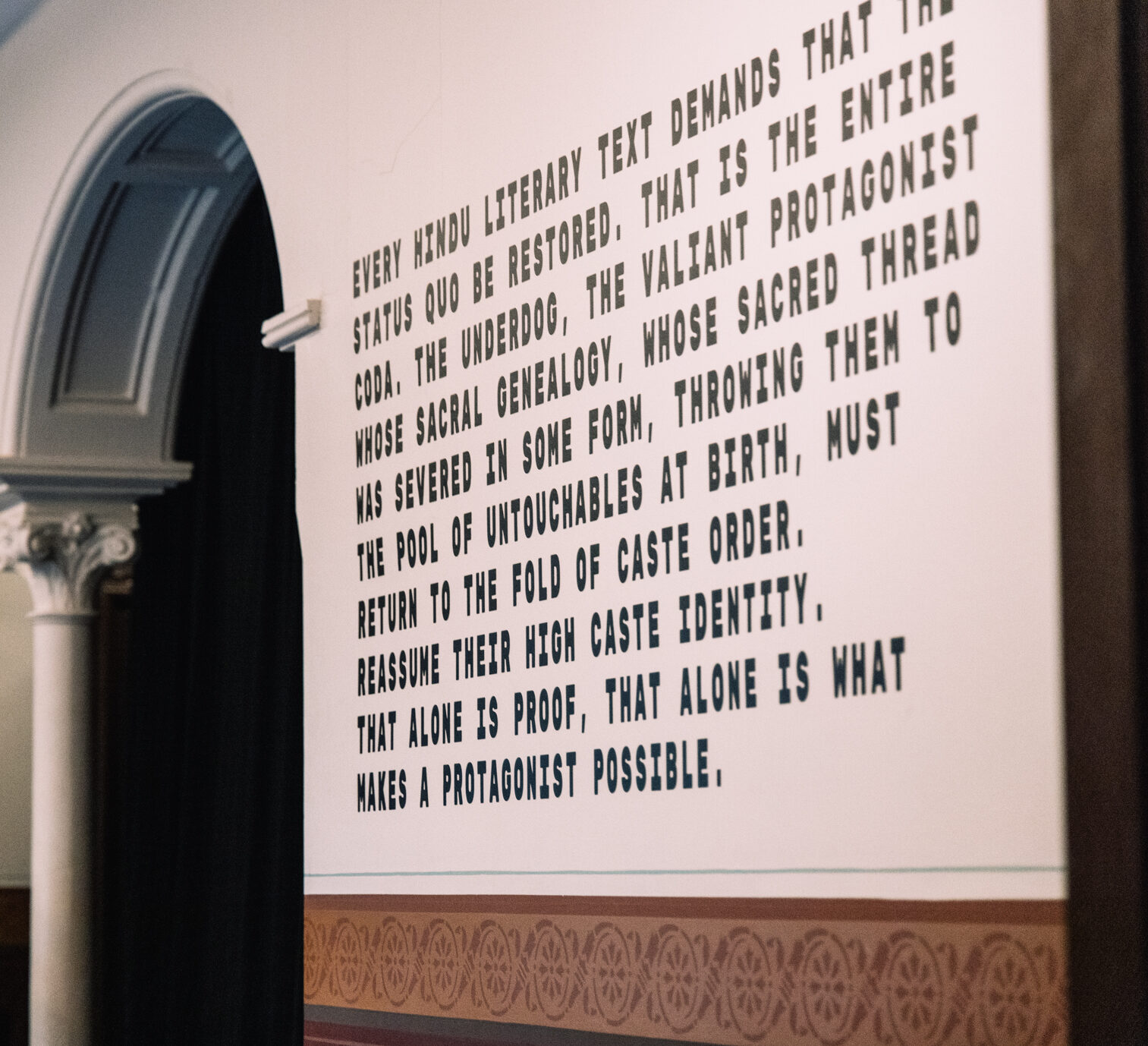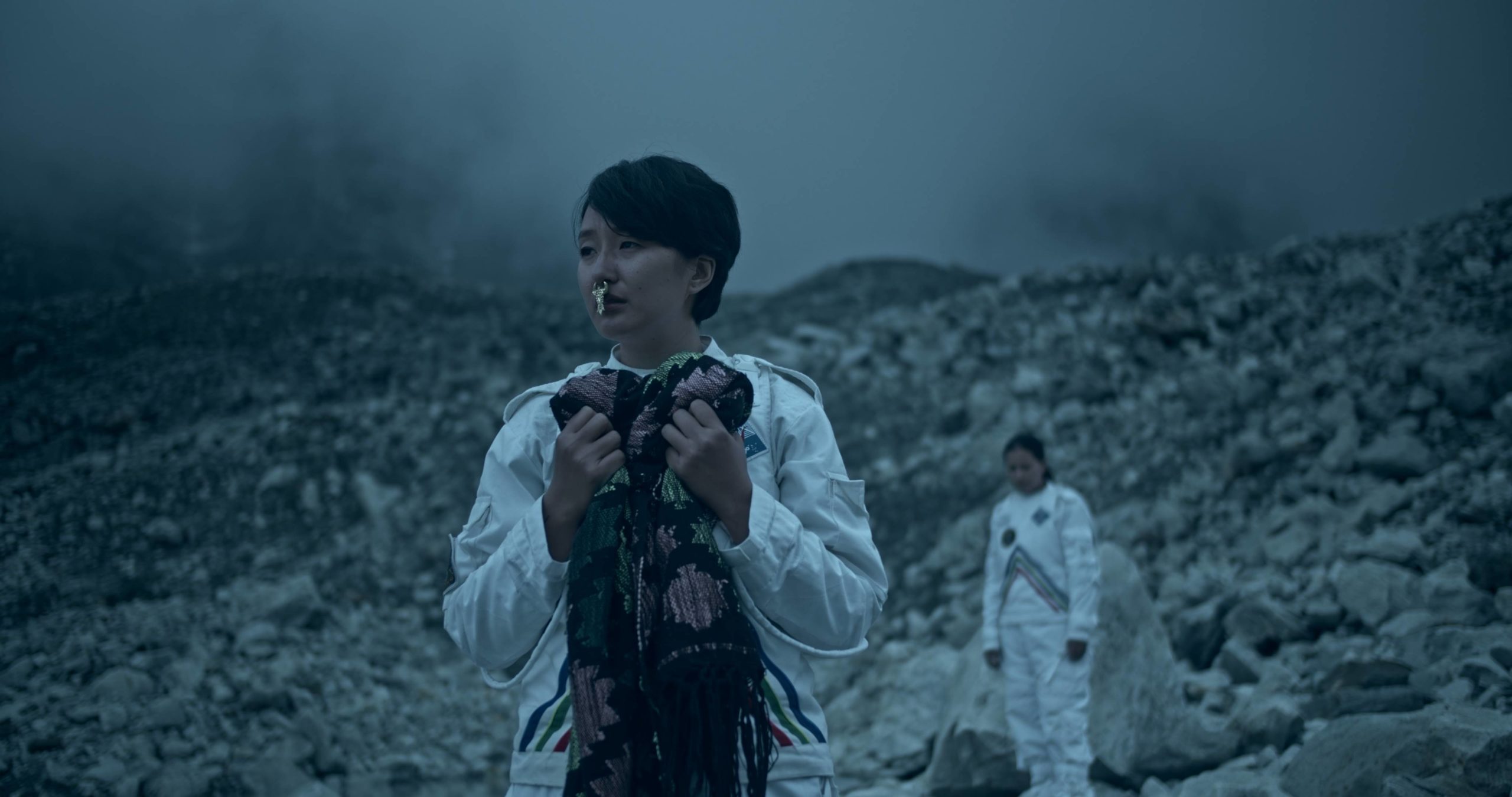Glossary of Concepts
Written by Liang Luscombe
Liang Luscombe wayfinds her experience through Okkoota ಒಕ್ಕೂಟ and its imprints on the building through a glossary
Okkoota: to assemble without contest
An event that allows for caste rules to be suspended temporarily, for example, the flattening of social hierarchies that occurs during a funeral procession. This can occur, in part, because the subjects are in movement; to be a Dalit who is stationary or loitering is to be a danger to the state. Dalit literally translates as ‘broken but resilient’; it’s a self-determined term for people deeply oppressed by the caste system in India. Dalit communities continue to be forced into bonded agricultural labour, manual scavenging, and other forms of slavery. For this reason, Okkoota imagines a gathering of artistic works and community, free of social stratification, that occurs outside of festivals and funerals.
Fissures and cracks that form within institutional legacies and colonial architecture
When a visitor to Okkoota first enters Arts House (originally a Town Hall built in 1876 in the Victorian architecture style), they come across a threshold: the foyer. It is only after crossing this threshold and turning back (perhaps on their return through the exhibition) that they come to Rahee Punyashloka’s bold text decals adhered to the material surface of Arts House’s archway. The text reads, “DALIT BODIES ERUPT OUTSIDE THE DIVINE HINDU CORPUS ”. It is here, within a liminal space, that Punyashloka proclaims the atrocities of caste-based discrimination and explicitly names his Dalit community as a group of impossible subjects for Hindu fundamentalist India.
Punyashloka’s truth-telling works remind us that you cannot enter a building that has no surface to hold you, and has no place for you to loiter. Admission can only occur when the institution develops some self-awareness and admits that the ever-present remnants of colonial power still swirl around them.
Lessons from the anti-caste movement: Educate, Agitate & Organise
Babasaheb Ambedkar – a pioneer of the Dalit movement, a social reformer and India’s first Justice Minister – used the slogan “Educate, Agitate & Organise” in his 1942 speech to the All-India Depressed Classes Conference to drive home the point that the anti-caste movement must embed cultural memory within political anti-caste organising in order to separate themselves from the Hindu caste system. As he said in his speech, ‘The Annihilation of Caste,’ “the emancipation of the mind and the soul is a necessary preliminary for the political expansion of the people”. [1]
So how do the artistic works of Okkoota take on Ambedkar’s call to action? How do they approach cultural memory? In Sancintya Mohini Simpson’s three-channel video In the Fields of Cane (2018), she presents us with a double portrait of herself and her mother while they stand in front of a field of sugarcane that towers above them. Alongside these images we hear Simpson tell the submerged histories of her great-grandmother, of the Girmitya women who were taken from South India to South Africa and forced into indentured labour in the late 1800s and into the early 1900s. Throughout the process of memorialisation, Simpson draws links between herself and her great-grandmother, saying, “They bled, like I bleed, the same.” Here Simpsons reveals a doubling across matriarchal lines, creating a political spell that allows her to reach back into the intergenerational horrors of enslavement of Girmitya women, many of whom belonged to Dalit and caste-oppressed communities.
The lustre of gold
Gold glimmers in the rich surfaces of Kirtika Kain’s paintings in Okkoota. Influenced by being a part of the Dalit diaspora in Australia, Kain employs materials from Hindu religious festivals and prayers such as cotton wicks, pigments, powders, and wax, transformed from their traditional usages to create an embalmed shell. Interspersed between these materials is gold leaf, which flickers and is then submerged under the weight of these alchemical veneers. For Kain, gold is a metaphor for the resilience of the Dalit body, and it acts as a reclamation historically denied to Dalit bodies because of their association with ritual impurity and pollution.
Moving from identity politics toward civilisational politics
What is the significance of India’s caste system to Arts House, an arts institution in Melbourne, Australia? For one, the caste system, held in the body across generations, travels on the heels of the Indian diaspora, and is practiced by that diaspora across both South Asia and Australia. Secondly, Okkoota’s use of an anti-caste lens holds lessons for the way we might think about identity-based cultural production within the settler colony of Australia. The phrase “Moving from identity politics towards civilisational politics”, is indebted to the thinking of cultural critic D R Nagaraj, who wrote extensively on the Dalit movement and its literature. In his writings he argued that the identity politics that Dalit leaders, activists and modern writers have pursued since Ambedkar functions as a discursive rejection of their humiliating pasts and the traditional Hindu world which denigrates them. This has resulted in a “The poetics of segregation and self-banishment has created its own politics in terms of self-representation. The self-conscious Dalit imagination is forced to adopt the bonsai mode and recreate the woods in this compressed space.” At the core of such a politics, he argues, is a cultural amnesia which gives a limited self-definition of a Dalit as a “totally impoverished being at all levels of existence”. [2]
Nagaraj then calls for a new aesthetic for Indian culture, not an isolationist view to Dalit literature, but one of civilisational politics that challenges the hegemonic modes of segregation and embraces cultural memory. We see this once again in exhibition curator Vishal Kumaraswamy’s use of an anti-caste lens: instead of focusing solely on the Dalit community, Okkoota finds alliance in a transnational grouping of artistic works from artists based both in Australia and South Asia, whose practices draw on ancestral legacies in the face of the colonial power. The exhibition is formed out of differing legacies of displacement, which have often been papered over or scrubbed out. These gaps create crosscurrent conversations that allow us to reflect on what a civilisational politics might feel like.
Subaltern Futurism: how do we make space and new temporalities to exercise our autonomy in the Global South?
Developed by Okkoota’s curator, Subaltern Futurism is an important precursor to Okkoota and is a practice-led framework for artistic research, practice, and the technological education of marginalised communities with an ethos of open access. Subaltern Futurism provides us with a politics of access to the digital commons from the lens of Kumaraswamy’s own Dalit heritage and a desire to support actual subaltern scholarship. It posits that artistic practice must formulate empathetic and pragmatic actions to shape the imagination of radical futures arising in the Global South. It expands upon Italian Marxist Antonio Gramsci’s postcolonial notion of the subaltern as “colonial populations who are excluded from the hierarchy of power” to accurately contextualise the true subaltern population across South Asia and its many diasporas.
In using the term subaltern, Kumaraswamy draws a line between subaltern studies as a field of study popularised and colonised by upper-caste scholars such as Gayatri Chakravorty Spivak, Ramachandra Guha, and Partha Chatterjee and the scholarship and cultural production arising from the actual subaltern Dalit, Bahujan, and Adivasi communities. Subaltern Futurism is therefore a divergent timeline that discounts the entire codified field of study established by academics without any real lived-experience of caste and subalternity. This method of appointing themselves authorities on the Subaltern condition, the false approximations are reminiscent of caste-based oppressive tactics that have gatekept knowledge production as only arising from the upper castes. Subaltern Futurism is focused on opening up spaces for historical modes of knowledge production to mark their legibility and re-write the discourse of representation and inclusion.
[1] Dr Babasaheb Ambedkar, Writing and Speeches Vol. 1, (Dr Ambedkar Foundation: New Dehli, 1979), 44.
[2] D R Nagaraj, The Flaming Feet and Other Essays: The Dalit Movement in India (Permanent Black: India, 2010), 4.
Image Credit: Loss in the Aftermath, Phuong Ngo. Curated by Vishal Kumaraswamy as part of Okkoota ಒಕ್ಕೂಟ. Photo by Matthew Stanton.



